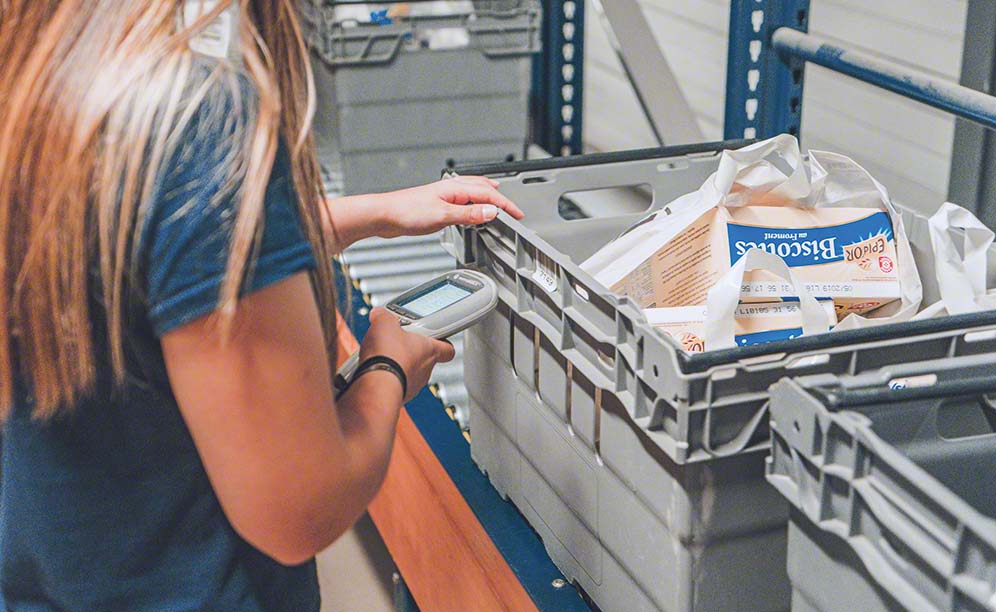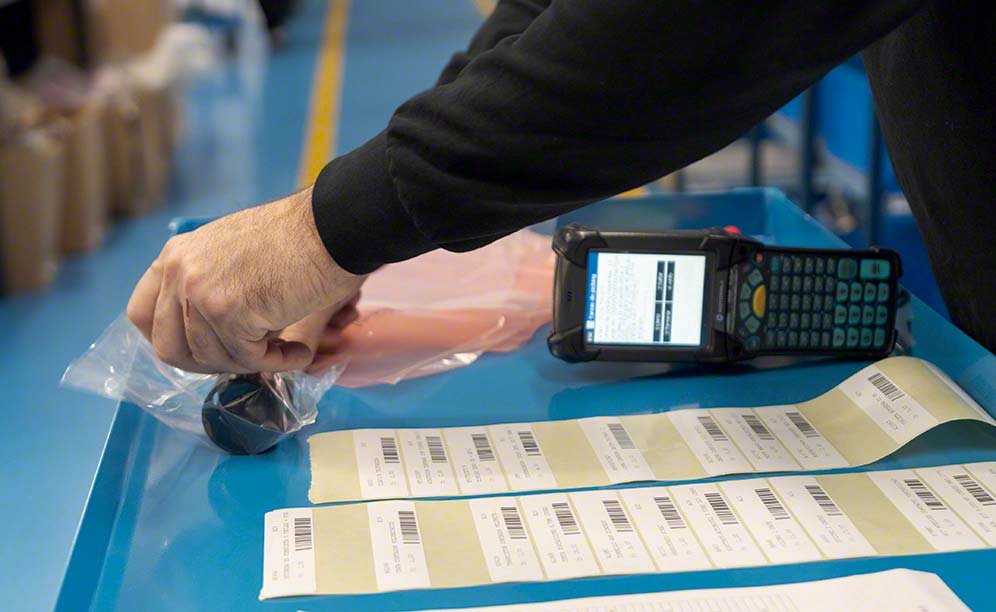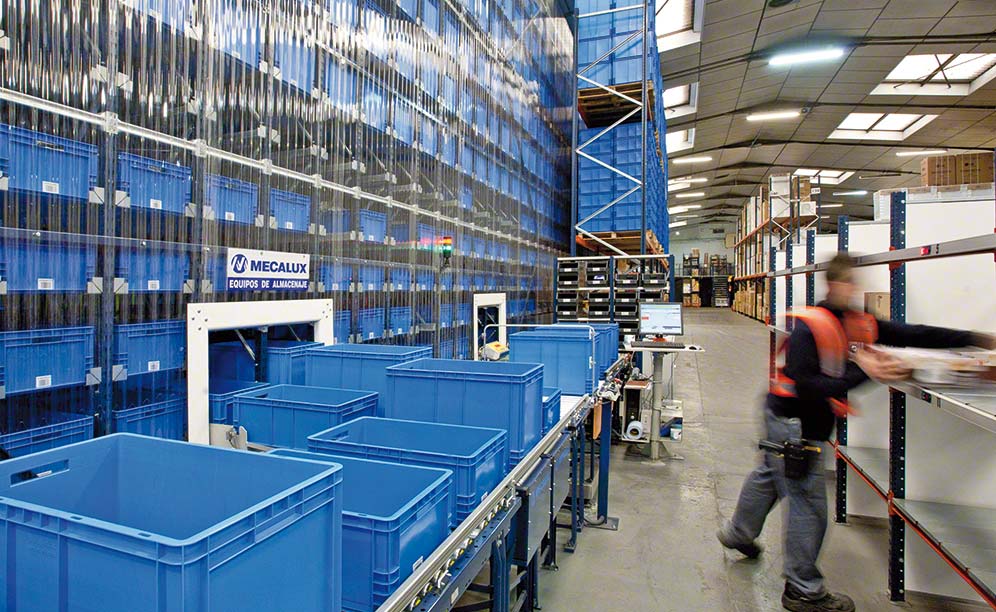
“Companies won’t be able to survive without a proper warehouse management system”
Watch the video of the full interview >
Vaggelis Giannikas, Director of the Centre for Smart Warehousing and Logistics Systems at the University of Bath
About the expertVaggelis Giannikas is the Director of the Centre for Smart Warehousing and Logistics Systems at the University of Bath (United Kingdom). An Associate Professor of Operations and Supply Chain Management, he is also the Director of Studies for the MSc in Operations, Logistics, and Supply Chain Management. Prior to joining Bath, he was a Research Associate at the University of Cambridge, where he also co-led the Cambridge Auto-ID Lab. His research focuses on the application of digital technologies in logistics, manufacturing, and supply chain management. His work explores how digital technologies can help manage and support business operations in a more intelligent way.
Mecalux interviews Vaggelis Giannikas, Director of the Centre for Smart Warehousing and Logistics Systems (Univ. of Bath), on the importance of a WMS.
-
The Centre for Smart Warehousing and Logistics has developed an algorithm that calculates the optimal distance between warehouses and delivery addresses. This tool has saved businesses over $2 million. How does it work?
First of all, all the credit should be given to my colleague Prof. Güneş Erdoğan, the main researcher behind this work. The vehicle routing problem is an issue that most logistics providers and transportation companies face. When you have a warehouse or a distribution center, multiple destination points and clients, and a variable number of vehicles and sizes, the question becomes: How do you decide which vehicle goes to which client, and in what sequence? What’s the best way to optimize this problem, minimize costs, and maximize service levels?
The tool he has developed allows users to enter some data about the vehicles they have and their clients’ requirements and locations, and then the algorithm automatically calculates the best way to serve those customers. Companies and organizations can experiment with this tool — it’s free — to find the optimal distance between their warehouses and delivery points. The algorithm can help businesses save money and reduce costs.
-
In your publication Examining the value of flexible logistics offerings, you stress the importance of flexibility in logistics. What are flexible logistics offerings and why should companies care about them?
We looked into how customers’ expectations change over time and how logistics can be flexible to support those changing needs. In particular, we analyzed how shoppers change their minds after placing an order. Up until recently, when you placed an order through a retail store or online shop, you couldn’t do anything about it, and in many countries, that’s still the case. When you purchase an item, you can make some decisions about delivery speed, delivery slots, and so on, but if you want to change other order details, you often have to contact the company. Somebody needs to pick up the phone and go through their system. Normally their response is: Sorry, we can’t really change your order, you have to receive it; and if you don’t want it, then you have to return it and place a new order.
But now, certainly in the UK, some state-of-the-art retailers and couriers allow some flexibility after you place your order. It used to be flexibility in small things, like being able to postpone the delivery by a day or two. Then it became about delivering the order to a different place, maybe to your neighbor. Many of those businesses now are thinking: if our customers change their minds, or their requirements change, how can we satisfy those sorts of needs? We discovered that the value of an order depends on the circumstances, and, therefore, the value of flexibility in that order varies as well.

-
How so?
Let me give you an example. A regular dress that you order online might cost $30 or $40. Now, if that dress is a gift for your partner’s birthday, the value of the item is no longer $40 — it’s way more. Why? Because if you don’t have it on time, well, the cost can be enormous… It’s useless to you if it arrives the next day because you no longer need it. So if you change your mind about wanting something earlier or at a different place, or about the very contents of the order itself, you shouldn’t just look at the value of the item that will be delivered to you. You need to look into the value of that item to you as the customer. Our research shows that the value of flexibility is quite often related to the value of the product to the customer rather than the monetary value of the item.
-
Why should companies care about this flexibility?
If you’re a retailer, you need to get as close to your customer as you can because that’s how you satisfy your clients’ needs — and retailing is all about customer satisfaction. When clients place an order, that’s when you, as a retailer, can allow them to make choices that are closer to satisfying their needs. If there’s no interaction with your customers beyond that point, when those needs change, you’ll no longer know about it and won’t be able to satisfy their needs. The main reason why companies should care about flexibility is to increase customer satisfaction because requirements between order placement and delivery change quite often.
Warehouses are now a key part of the overall consumer experience
But regardless of whether you’re a retailer or a logistics provider, there’s another side effect when you don’t offer flexibility: added costs. If you deliver something and your customer happens not to be there, then chances are you’ll have to go back to the warehouse and bring it back again. So an extra trip for no good reason. If your customer decides that they need to return the item and they already know that but can’t cancel the order, then someone will again need to pick it up and take it back. The very fact that you’re delivering a product that someone doesn’t need anymore means that you have to process it in your warehouse, pay someone to load it in the van and deliver it, and so forth. Businesses that offer flexible logistics can reduce costs and streamline operations.
-
Your research shows that digital technologies are a critical factor in ensuring flexible logistics.
One of the key aspects is extending the interface and interaction with customers after order placement to offer that flexibility that some people need. The retailer may not see it as critical because they’ve already made the sale, but it’s a crucial step for overall customer satisfaction. Now, if you really want to have a proper interface to satisfy your customer’s needs, chances are you’ll have to rely on some sort of digital technology.
The fact that most consumers now carry a smartphone with them all the time makes a huge difference: it means that as a company, you can get really close to them without having to worry too much about where they are or whether they’ll have access to a network. This means that businesses will have to start thinking about creating that interface, which can be a simple email that updates you with the most recent information or a text that says: “If you’re not home, please press one, and we’ll deliver tomorrow,” or “Press two and we’ll deliver to your designated address.” Another alternative is an app that allows you to track your order and also influence what’s happening, like asking for faster delivery or changing the delivery address to a different place, and so on.
Many people reading this may be thinking: well, that’s happening quite often. Actually, not really. If you just go back 5 to 10 years, when you tried to order something online, the experience was very different. Many companies out there, including warehousing businesses, are still in that stage. They don’t have the necessary digital systems (both software and hardware) to enable them to interact with the end consumer.
-

"Digital technologies around identifying and tracing orders are critical to ensure flexible warehouse operations" What measures can organizations apply in their warehouses to make their logistics operations more flexible?
To properly allow flexibility, companies will require digital technologies in their business and in their warehouses. For example, if a customer tells you that they now need something new — like an extra item in their basket or a faster delivery — you don’t just need to know that your client’s requirements have changed. You also need to alter your operations to make it work. It means that you need to locate the order very quickly: Has it been sitting in a warehouse management system (WMS) database? Is it being prepared? Is someone picking it up as we speak? Has it been labeled? Is it in a sortation area of the warehouse? Locating where the order is in the logistics facility is crucial. And sure, you can send someone around the warehouse to see where it is, but if you have some sort of auto ID system with a barcode, an RFID, or a QR code, you’ll be able to trace the order more easily and effectively. And then, once you find the order, you need to think about what you can do about it. If you need an extra item, can your WMS change the plan, alter the pick list, and dynamically reroute your pickers? Can your labeling machine be updated so that it no longer prints the initial delivery date but a new one? Do your pickers know about that change and can they alter the order?
Digital technologies around identifying and tracing orders are critical to ensure flexible operations in the warehouse. Also, decision-making software that enables you to better replan or dynamically plan your operations can be quite useful.
-
Can warehouses with large volumes of orders survive without a software program?
When you walked into a warehouse a few years ago, you had people printing pick lists and going around to pick up stuff. Even though you may think that’s no longer happening, it’s still the case in many facilities around the world. I don’t know how companies can or will be able to survive without a proper warehouse management system (WMS) in place. Logistics software can streamline and optimize your operations because you no longer have to rely too much on the knowledge of people in the warehouse: you have smart algorithms running in the background, telling you what to do rather than relying on your employees to do what they think might be best. I’m a big fan of warehouse management systems and utilizing digital technologies — including software and hardware — in warehouses.
-
What would you say is the greatest benefit for warehouses with flexible logistics?
Warehouses are now a key part of the overall consumer experience. Even though many shoppers don’t know it, your order is very likely to start in a warehouse. So you want things to be seamless behind the scenes to keep customers happy. Making sure that what’s happening in the warehouse is flexible enough to cater to changing customer needs has a direct impact on consumer satisfaction.
There are other aspects of warehouse management where I believe flexibility is also important, especially in cases where the environment around you changes in ways you don’t expect. For example, if you’re a very traditional organization and you’ve run your business the same way for the past decade, you may argue that the environment doesn’t change that much and you know your requirements, so flexibility in your warehouse is not that important for you. But from physical events that you have no control over (e.g., earthquakes or fires) to biological events like Covid or political ones like Brexit, it’s really hard to predict whether they’ll have an impact on your demand going up or down. It’s also difficult to know whether they’ll affect your lead times — or maybe the very product that you’re storing in your facility may change because consumer requirements change. So companies need to keep up with changing aspects in the environment, whether they’re volumes, physical goods, or client expectations for lead times or value-added services.
-
What role does flexibility play for third-party logistics providers?
Third-party logistics (3PL) providers rely on working for other clients. Even if a 3PL doesn’t want to change what it does, clients might change what they want to do. How do you adapt to that? Do you try to find new clients that are closer to what you already know? Or do you try to be flexible to satisfy their new needs? If your client decides to change the size of their boxes, it’s not very common for the 3PL to go back to the marketing and manufacturing teams and ask them to change the size. But knowing that you have a business model that relies on the decisions of an external organization means that unless you’re flexible enough to adapt your operations and services to what your clients want, chances are you’re going to fail long-term. This is because the market around you will change, and 3PLs don’t tend to be those giants who can dictate what others do. It’s normally the other way around — a huge retailer is going to tell you what to do. I can’t imagine how warehousing companies will survive without flexibility in a world that’s constantly changing and where customer requirements keep evolving as well.

-
What are the pros and cons of fast deliveries?
I think that as an industry, we’re trying to satisfy customer needs that, although they may appear to be popular nowadays, I don’t believe are very real. We as consumers are often driven by consumerism and privilege. If something can be delivered to you in 15 minutes, why wait two hours? We feel like we deserve to get our product as fast as possible. Or if you’ve paid Amazon Prime, for example, for next-day delivery, even though you don’t need the item for the following day, why wait for a week? You feel like the company owes it to you to deliver the next day. So I think that because speed is something that most people enjoy and is attractive to consumers, organizations have tried to adapt to offer faster and faster deliveries. But I believe this is not a sustainable model, and eventually, it’s going to backfire. In many countries, you can see that companies that offer ultra-fast deliveries are failing, mainly because the business model is not there or the logistics costs are very, very high. Sure, there’s going to be a market for ultra-fast deliveries, but for very specific things — such as when you don’t have something that you really need and there’s no other way to buy it — someone will have to bring it to you.
-
How fast is too fast?
One aspect we’re trying to understand in our research is how much consumers value speed. If you ask them: Do you want more speed? The answer is always yes. But to me, that’s the wrong question to ask because if you ask if you want more of something, of course, you’ll say yes. We’re running experiments to look into how much customers are willing to pay for different delivery speeds. We’re asking them whether they’d be willing to wait for an extra day or an extra 5 to 10 days if, in return, we give them a discount.
-
What are your experiments showing?
We’re still running our experiments, but we’ve already seen that there’s a certain part of the market that’s willing to wait for an extra 5, 10, or even 15 days for a small discount. That’s quite powerful because knowing that there’s a substantial percentage of your customers who would be willing to slow down their deliveries in exchange for a small discount can help retailers and warehousing and transportation companies refine their strategies.
If we can incentivize consumers to choose not faster but slower deliveries, this could have a positive impact on warehousing and transportation businesses and retailers because they could better manage their inventory. It would also have a positive impact on the environment, as it would mean less packaging, less space in the van, and fewer half-empty trucks on the road that you could have filled if you’d waited a few more days. It’s quite important to understand not only how you can make deliveries faster and faster, but also how you can incentivize people to make slower and more sustainable decisions overall. Being more sustainable in your deliveries often means you can have all sorts of positive knock-on effects across the supply chain as well.
